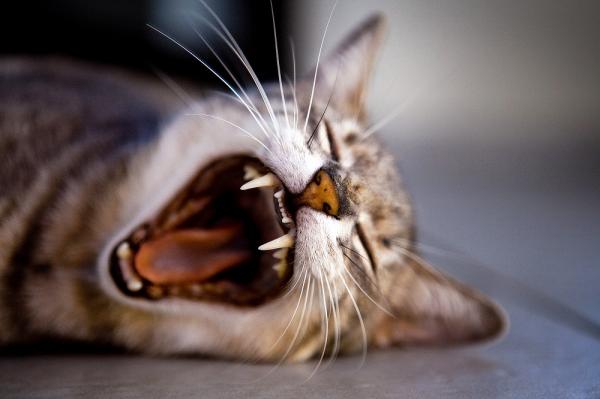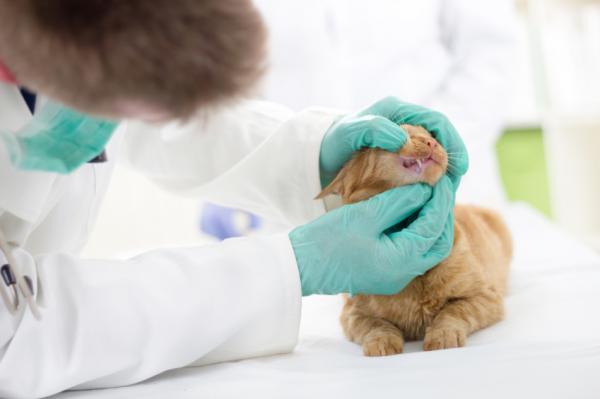Mouth diseases in more common cats

Most of the time cats use their mouths to explore the world. They not only use it to eat, but also to catch their prey, nibble something that makes them curious and play, among other activities. For this very reason, they are prone to suffer different ailments in your teeth.
All these diseases cause a lot of pain in cats, so they should be taken care of immediately. It is best to detect them in time to avoid complications, so this guide about diseases of the mouth of the most common cats.
Periodontal disease
This term is used to cover diseases that involve the involvement of Periodontal tissues. They are usually caused by the appearance and extension of the plate, it converts into tartar and it begins to infect different zones, being able to affect from the gum and the dental piece, until the own root.
It is estimated that approximately 70% of cats suffer some type of periodontal disease after the 5 years of age. Now, it usually affects them in the stages of tartar, gingivitis and periodontitis, so we explain a little more about them below.
1. Tartar
This is the first stage of periodontal disease. The mouth of all animals is full of different types of bacteria, and the cat is no exception. However, when you are bacteria are mixed with food debris and external microorganisms, little by little it is forming the Dental plaque.
This plate, if it is not kept to scratch with proper hygienic habits, begins a process of sedimentation until it becomes annoying tartar. This is the culprit of the dental diseases described below. We have several options to eliminate tartar, such as brushing or the use of snacks and dental toys.
2. Gingivitis
Is the second stage of periodontal disease is gingivitis. It affects the gums, And is reversible if it is detected in time. It is usually caused by the proliferation of dental plaque transformed into tartar, or by injuries in the oral cavity that accumulate bacteria and trigger an infection.
It manifests as Redness of the gums, Bleeding when there are injuries, rubbing the jaws with the legs, pain e inflammation, so the cat will show discomfort when it comes to eating their food. If not treated in time, gingivitis can affect other areas of the mouth and digestive system, giving way not only to periodontitis, but also to stomatitis.
The treatment of gingivitis that is applied includes not only brushing using veterinary toothpaste, but also application of antibiotics and healing drugs, in order to attack the bacteria and heal possible injuries. Cats in a weak state due to blood loss may also require some vitamins, but only the specialist’s review will be able to determine this.
3. Periodontitis
There is talk of periodontitis when the infection has spread to affect the tissues that support the tooth, affecting not only the gum but also the bone. At this point, the disease is irreversible.
Among the symptoms is bad breath, excess salivation, fever, Bleeding, discomfort to eat, irritability and an eventual anorexia If the painting is not treated. The danger of the disease lies not only in that, at this stage, part of the treatment includes the extraction of infected teeth, but also the pus itself of the infection will be swallowed by the cat when feeding, transporting these bacteria by the body, where they are able to affect the liver, heart and kidneys.
The diagnosis is made by studying the oral cavity deeply, making x-rays and with blood and urine studies to detect the presence of a virus. The treatment includes medication indicated to control pain and fight bacteria, extraction of affected teeth and care of the area for better healing. All this at the hand of a specialist.

Neck injury
It is another oral condition that often affects cats, and occurs when the body itself begins to absorb portions of enamel and dentin until giving way to an exposed root. The origin or cause of this phenomenon is still under study. The feline will experience pain and the appearance of the teeth will begin to look strange.
Its identification can be done at a glance, since it is characterized by presence of red spots in the area, although for a better diagnosis it is recommended to perform an X-ray. The treatment is intended to alleviate the discomfort they cause in the patient, which is why drugs for pain are prescribed. The veterinarian will indicate which is the best measure to prevent the progression of the disease, according to the severity of each case, being able to reach the extraction of the affected parts.
Carcinoma
It is a type of cancer that affects the oral mucosa. Its appearance is that of ulcers and masses of squamous tissue, usually affecting felines of 9 years of age and older. It is quite painful, so the cat will refuse to eat and will often pass its claws through its mouth.
If your cat suffers from carcinoma, or suspects that it suffers, you should go to the veterinarian immediately. A biopsy and other studies will confirm the theory, and according to the status of the feline and the level of cancer progression will continue to most appropriate treatment.
Dental resorption
It is a condition of unknown origin, which affects especially those who have reached old age. The tissue that covers the tooth deteriorates little by little, until it breaks the piece. It is a long and painful process, characterized by the denial of your cat to eat and a frequent drooling.
The specialist will recommend painkillers for pain, and depending on the progress of the disease it will be treatable with surgery to remove the damaged pieces, or with different antibiotics.

Loss of the crown
Approximately half of adult cats get to suffer from this problem at least once in their life. It’s about the fall or separation of the dental crown with respect to the root, due to an undermining of it. The causes are multiple, but usually it can happen when a piece falls or starts improperly, either during a fight, when biting something very rigid, among other reasons.
Periodontal disease is also one of the main causes of this loss of the crown, since the infection itself weakens all the tissues, making them more vulnerable.
Trauma
Although it is not disease itself, most oral injuries that affect cats are traumatic. These have different causes, from a hit received, the result of a fight with another feline or animal, an object that has been trapped between the teeth and even breaking one for biting something too hard.
The symptoms of these problems will be varied, but usually they are characterized by rejection of food, drooling, irritable attitude, Bleeding, pain, Among others.
Prevention
When it comes to oral diseases, it is best to advocate prevention more than by healing. These types of conditions generate a lot of pain and discomfort in your cat, do not risk losing your teeth.
Follow the following tips to avoid health problems:
- Choose a dry diet. Moist foods tend to stick more easily between the teeth and gums, causing infections. In addition, there are high fiber feeds that work like mechanical brushing, ripping off the accumulated plate and sweeping away any residue.
- Fresh water. Water is essential for the health of your cat, especially to avoid dehydration and the many problems it can cause. You should always have fresh water and clean the 24 hours of the day.
- Weekly brushing. Brushing a cat’s teeth is not an easy task, so we recommend you to get used to this routine from a young age. Use a veterinary toothbrush and toothpaste for this process.
- Toys. In the market there are different teething toys that will make a sweep of anything that may be embedded in the teeth of your cat, choose the one that suits you best.
- Vitamins Check with your veterinarian the need to give your cat some vitamins that allow him to strengthen the bones, and therefore the teeth, such as calcium and collagen.
- Annual review. Once a year, go to your trusted veterinarian to have a check of all the teeth and oral cavity of your cat, so you can detect any problem in time.

This article is merely informative, in .com we do not have the faculty to prescribe veterinary treatments or make any kind of diagnosis. We invite you to take your pet to the veterinarian in case of any type of condition or discomfort.
If you want to read more articles similar to Mouth diseases in more common cats, we recommend that you enter in our section of Other health problems.


